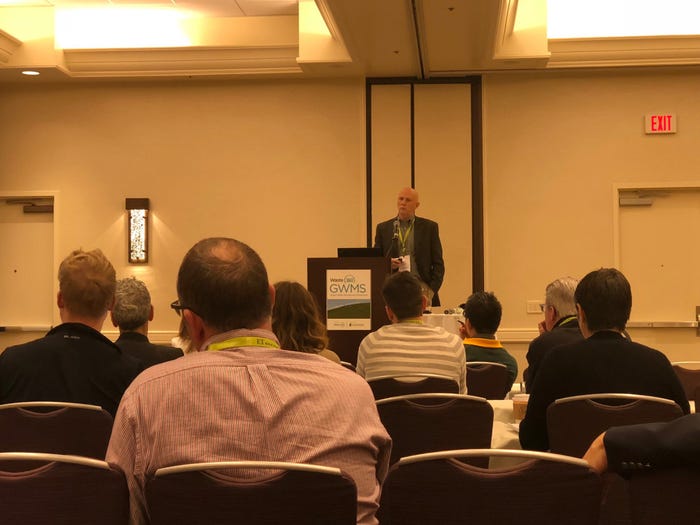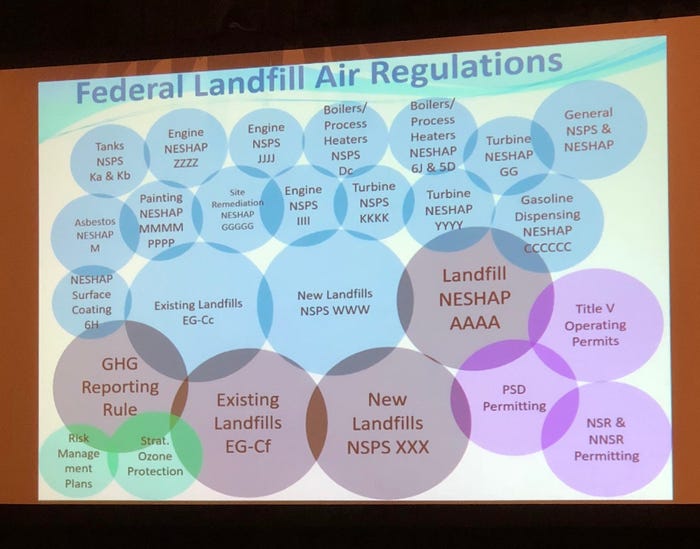Key Takeaways from Day Two at GWMS 2018
The technical conference was host to several talks and panels in its second day.

Day two of the Global Waste Management Symposium (GWMS) being held at the Hyatt Regency Indian Wells Resort & Spa in Indian Wells, Calif., featured another round of informative and engaging sessions covering all aspects of the waste and recycling industry, including leachate disposal at POTWs, recycling and diversion, leachate treatment, organics diversion and processing, coal combustion residuals, temperature monitoring and control, landfill air regulations, composting and more.
Here are some key takeaways from the second day of GWMS 2018:
At the recycling and diversion session, Luc De Baere of Organic Waste Systems presented two-year results on the production of saleable products from municipal solid waste (MSW), Michelle Leonard of SCS Engineers shared the "Rural Recycling Hub and Spoke Recycling Project" studythat SCS Engineers completed for the Iowa Department of Natural Resources and the many benefits of a hub and spoke recycling system and Thanos Bourtsalas of Columbia University highlighted a comparative study of four European mechanical biological treatment plants.
De Baere said organics in mixed MSW represent the largest potential for increasing diversion and recycling.
De Baere also stated that the necessary ingredients for successful recycling include communities with separate collection of recyclable materials, citizens who separate recyclables at the source and markets that can use/make profit from the recyclable materials.
Leonard explained that a hub and spoke recycling system consists of centralized processing centers (hubs) and surrounding communities (spokes) that feed the recyclables they collect to the main hubs.

In the organics diversion session, Ken Beaver of Environmental Solutions Group highlighted the trade-offs between collection and processing costs when implementing an organics diversion program, Leslie Lukacs talked about Santa Clara County, Calif.’s composting processing capacity and organics diversion study and Wilbert Yang of Tetra Tech spoke about how a Western Canada success story is significantly reducing our trash.
Beaver stated that food waste is the largest single component going into landfills today.
Beaver also shared that typically 80 percent of the revenues of anaerobic digestion (AD) facilities are tip fees and only 20 percent is the output, so for organic waste to become a viable process for recovering, that ratio has to be flipped.

Beaver highlighted the pros and cons of a one bin for all concept and a three bin concept:
One bin concept pros: Lowest collection cost (one bin to collect). Potentially high diversion rate, as all material goes to the materials recovery facility (MRF).
One bin concept cons: Highest processing cost due to the high capital and operating costs associated with a mixed waste processing MRF. Many still doubt the ability of a mixed waste processing MRF to successfully separate recyclables from organic waste, in particular.
Three bin concept pros: (Potentially) highest purity of incoming materials to the single stream recycling MRF and AD facilities.
Three bin concept cons: Highest collection costs (three separate bins to collect). Relies on generators to faithfully sort materials into the correct bins. Some generators may not have enough room to store three bins.
Lukacs highlighted the top 10 recommendations to manage and reduce organic waste in Santa Clara County:
Communicate with local and regional organics processors regarding future plans.
Establish a collaborative process for hauling and/or processing contracts to facilitate advance planning for collection and facilities.
Work with CalRecycle to obtain information on facility permitting and expansion plans and proposals.
Monitor and track grant opportunities.
Monitor and track the quality of organics generated from each city.
Consider implementing a local organics landfill disposal plan.
Implement enforcement measures to reduce the quantity of organic materials placed in waste receptacles.
Create incentives to support the transition to native landscaping that reduces organic waste.
Develop outreach campaigns to encourage native landscaping, grasscycling, backyard composting and correct food purchasing.
Conduct kitchen audits to measure the quantity of waste generated from the residential sector.
Yang explained the four steps that lead to behavior change: know your waste, work with your processor, public engagement and implementation considerations.
Yang also shared the six steps to clean compost: Start with the end in mind--Clean compost!, focus on the source, focus on cooperation, communicate, work with packaging producers and be consistent.
Yang broke down the three types of organics diversion programs—yard and garden waste only, yard and food waste and food waste only—and explained that the key requirements for these programs are that organics must be recycled weekly and trash and recyclables can be recycled weekly or bi-weekly.
In a panel discussion, Matt Stutz of Weaver Consultants Group, Amy Van Kolken Banister of Waste Management, Kerry Kelly of Waste Management, Niki Wuestenberg of Republic Services and Pat Sullivan of SCS Engineers discussed the evolving landfill air regulations, interpretations and enforcement initiatives under the Trump Administration.
The panel provided a timeline of landfill air regulations and displayed the regulations in a fun bubble graph.

The panel also provided updates on New Source Performance Standards XXX, Emission Guidelines Cf, Tier 4 requirements, the evolving landfill National Emissions Standards for Hazardous Air Pollutants, the Risk and Technology Review process, the evolving greenhouse gas reporting rule, the evolving landfill gas beneficial-use drivers, Environmental Protection Agency (EPA) Administrator Scott Pruitt’s priorities and the EPA’s enforcement initiatives at MSW landfills.
For up-to-date information throughout the event, follow @Waste360, @WasteExpo and #GWMS18 on Twitter and WasteExpo on Instagram. For more information about GWMS, click here.
About the Author
You May Also Like




.png?width=300&auto=webp&quality=80&disable=upscale)